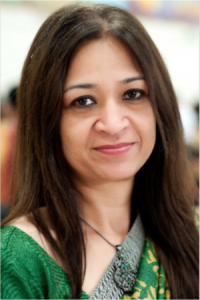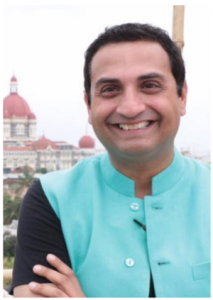A New Space For Indian Art – And So Much More
ArtandSeek.net August 10, 2018 13There’s a new art gallery and performance venue in the Design District. It’s called Center Stage and it opens August 19. The space is home base to the non-profit Dallas Indian Arts Collective. In this week’s State of the Arts, I chatted with the founders, Anu Agarwal and Jitin Hingorani. They told me that Center Stage will highlight art from South Asia. But they hope artists and art groups from around the area will use it.
Agarwal helped her husband, Arun, grow a side business selling table top accessories into a massive bed linen company, called Nextt. She was looking for a way to fold the arts into her everyday life, more than just a weekend outing. Hingorani has had a long career in journalism, non-profits and publicity. He launched the DFW South Asian Film Festival in Dallas. Agarwal was a supporter, and the two knew each other from other non-profit work. The pair formed the Dallas Indian Arts Collective to showcase and preserve Indian culture for South Asians, and introduce it to a larger audience.
The Agarwals purchased a warehouse near one of their own, and remodeled it to create Center Stage. When the space isn’t being used for DIAC programming, it will be available for rent. When I visited, workers were putting the finishing touches on the venue, which opens into gallery space, then leads to a stage and room that can seat 300.
You can click above to listen to our conversation, which aired on KERA FM. Or read excerpts below.
Center Stage, this new Indian arts center, has been something you both have dreamed about. What’s your vision?
Jitin Hingorani: I think it’s not just an Indian arts center. It is an arts-friendly complex that we’d like to gift to the city of Dallas, to be perfectly honest. Yes, it’s going to be the home for the Dallas Indian Arts Collective, but we really hope that it will be utilized by all the arts organizations in town, because we feel like there is a huge need for that in our community.

Anu Agarwal Photo: DIAC
Anu Agarwal: So although we are called Dallas Indian Arts Collective, that’s the Indian Part of that. But Center Stage should really should be the center stage for all of these small organizations to have their events and collaborate.At DIAC, we are focused on heritage-based programming – art forms, dance forms that are disappearing. And then there are similarities that we find in other cultures. And, perhaps at some point, we can collaborate and do something really fun.
Why the Design District?
JH: I feel like the areas where South Asians live and work, Plano, Richardson, Irving already have their spaces. There really isn’t a space in downtown Dallas or close to downtown Dallas, that showcases Indian arts. And that’s why we wanted to be close to the mainstream. Because again, this is not just for South Asians. We want everyone to come enjoy the work that we’re curating

Jitin Hingorani. Photo: DIAC
What is your vision for programming?
JH: We really want to focus on what’s hot and happening, but also blend that, and juxtapose that, with potentially ancient programming or arts that are disappearing.
And that’s reflected in the program for your opening event August 19th.
AA: Yes, so we have a photo exhibit by Lekha Singh, who’s a renowned artist [and filmmaker]. After many, many years she’s going to be showing her work locally, in Dallas. And also we have a group performing Kathak, which is a traditional form of dance.
JH: And also, two of the dancers who are part of these three groups that are going to be performing, they’re actually the judges for “Dance India Dance,” which is where the popular aspect comes in. They’re seen on television. They’re judges for the Indian version of “So You Think You Can Dance.”
So having that blend of these artists who are at the top their game when it comes to Kathak right now, we’re really proud to be able to showcase this talent on our stage.

Orange, by Lekha Singh
You’ve said you want to go beyond Bollywood in your programming. What did you mean by that?
JH: In the last decade, Bollywood has really become its own form in mainstream America. Most people know what Bollywood is. However, we want to take it a step beyond. We want to showcase the arts that are disappearing, the arts that don’t have a voice, the arts that don’t have a stage. We want to showcase those arts, because there’s so much more to Indian arts than just Bollywood. And that’s what we mean by “beyond Bollywood”.
There’s a huge population of people of Indian or South Asian descent in North Texas. Do you feel like they are being culturally well-served?
AA: There’s definitely scope for more. India is much, much more than Bollywood. There’s like, how many dialects that we speak there? And even me, coming from India, I have not even seen certain kinds of performances. And India as you know is very diverse. And definitely, there are people in Dallas — there’s so much more that they are hungry for.
JH: And you know there are so many issues in the South Asian culture that are taboo issues like, domestic violence, female infanticide, sexuality, that can only be discussed through the arts, that can only be portrayed through the arts.
And that’s why we feel it’s so important in our programming to really focus on the level beyond, and to talk about some of these issues that we may not necessarily have the chance to talk about in our daily lives. And art allows us to do that. And we really want to focus on curating that kind of art.

Anuj Mishra, Kantika Mishra & Neha Singh. Photo: Battery Dance Festival










